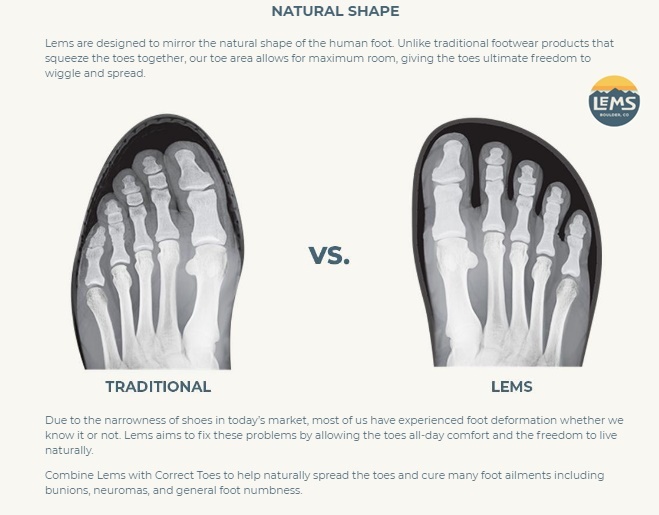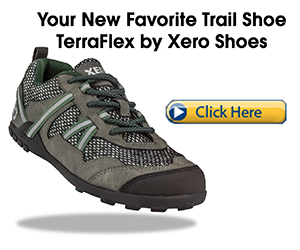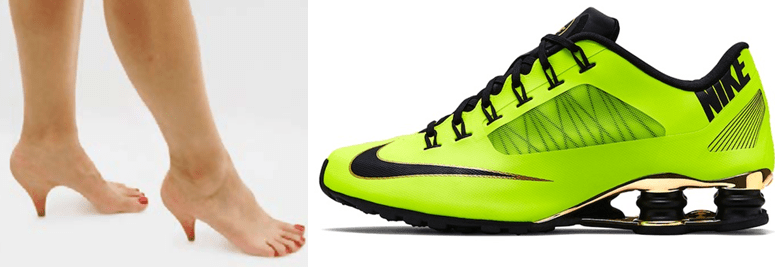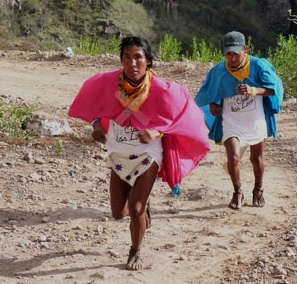Running shoes are always central to running, however a fast growing body of evidence indicates that running shoes with thick, soft cushioning, especially under the heel, are a source of injury because it was found to encourage more rigid landings with more downward force and inappropriate joint loadings at the ankle, knee and hips. Equally damaging, the loss of ground-feel (also known as proprioceptive disorder) due to the thick underfoot cushioning causes unbalanced, more force-intensive mechanics simply due to a lack of sensory involvement at the feet.

Worse still, foot strength tends to fade away with ongoing use of thick cushioned running shoes because these shoes are too inflexible and narrow to keep the feet engaged at a basic level.
Another problem is toe splay is prevented due to the narrow toe-box of the shoe whereby toe splay is essential for creating a wider platform for better balance and ground adaptation. But, when toe splay is restricted, more impact loads shift to the little bones that make up the forefoot, while causing structural weakness and changes to the forefoot, resulting in a bunion, shown below:



It is also well-sourced (references below article) that the heel-height of the conventional running shoe alters ankle kinematics which changed landing behaviour from a forefoot strike to a heel strike, while increasing frictional forces on the ankle-joint which in turn increases loading. This all eventually adds up to an ankle, shin or knee injury.
Last but not least, equally important to mention is the loss of ground-feel because it has strong ties to producing a greater downward force of the foot onto the ground where the effects ripple across the shins, while the compressible underfoot materials force the foot into extreme positions.
Another aspect of ground-feel that has proved to be incredibly important for foot health is increases in ground-feel, such as when barefoot or in barefoot-like shoes (minimalist shoes) helps to circulate nutrient-rich blood efficiently through the feet and helps keep the foot’s blood vessels healthy.
This is why cutting of ground-feel via thick cushioned running shoes can seriously weaken the feet because the raw sensory input when barefoot is the most powerful component of stimulating the soft tissues, fat pads, muscles, nerves and blood vessels to strengthen.
The Home Message
Most remain locked into an outdated picture of believing our feet are inherently delicate and injury-prone, but that is only when they are weak. The only way to maintain normal function and sustained strength, the feet requires a constant supply of ground-feel and engaging activity delivered via either barefoot or barefoot shoes, since cushioned running shoes robs the feet of the sensory input they need to thrive in ways that sustains.
Always remember, to date, no conclusive evidence proves that thick cushioned footwear prevents any running-related injuries, but it’s believed that early humans ran barefoot, or in minimal footwear such as moccasins, for millions of years and never had problems with shin splints, runners knee, or ankle sprains. Running injuries were virtually unheard of.

In the 1970’s, the architecture of the running shoe changed for the worse as stability elements and ridiculous quantities of cushioning were added, yet injury rates remain unacceptably high.
Consequently, the spike in running-related injuries has given running a bad reputation for being known as one of the most injurious forms of physical activity.
The truth is, our natural foot strength is grossly underestimated when in fact, our feet are stronger than we think.
If we run properly, in the same way as our ancestors, perhaps injury rates would drop along with the apprehension people have on running.
Read more here about all the evidence-based reasons you will benefit from minimalist shoes the most vs cushioned shoes.
If you’ve enjoyed this post, you’ll love my Youtube channel, here, where I show why forefoot running is better than heel strike running by all measures.

References:
Lohman et al. (2011). A comparison of the spatiotemporal parameters, kinematics, and biomechanics between shod, unshod, and minimally supported running as compared to walking.
Robbins, SE and Hanna, AM. Running-related injury prevention through barefoot adaptations. Med Sci Sport Exers, 1987; 19(2):148-56.

Bretta Riches
BSc Neurobiology; MSc Biomechanics candidate, ultra minimalist runner & founder of RunForefoot. I was a heel striker, always injured. I was inspired by the great Tirunesh Dibaba to try forefoot running. Now, I'm injury free. This is why I launched Run Forefoot, to advocate the health & performance benefits of forefoot running and to raise awareness on the dangers of heel striking, because the world needs to know.
Latest posts by Bretta Riches (see all)
- Can You Run In Barefoot Shoes? Yes, But DON’T Heel Strike! - 21/07/2024
- Why Cushioned Running Shoes Are Really Bad for Your Feet - 19/07/2024
- Do Cushioned Running Shoes Cause Injuries? - 17/07/2024

